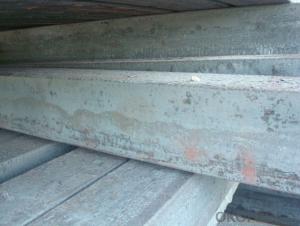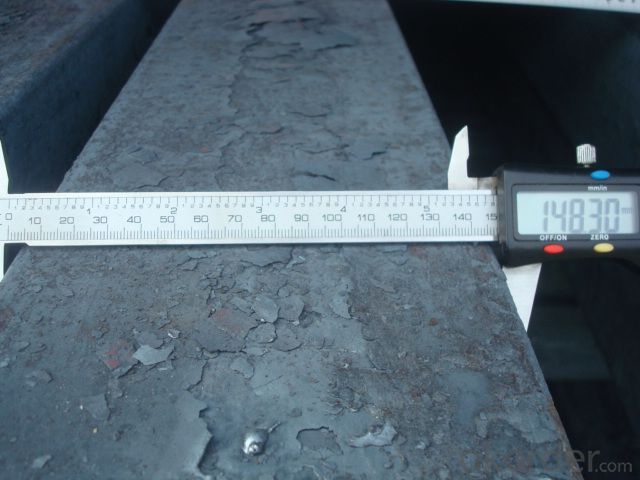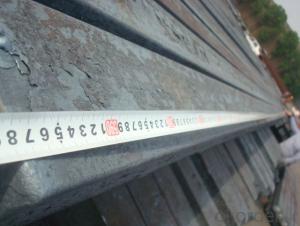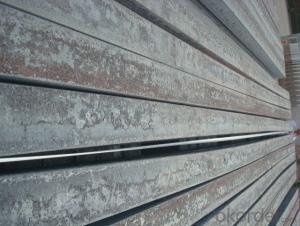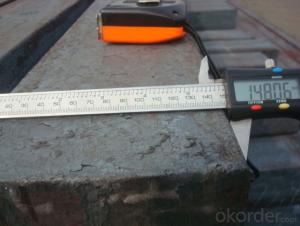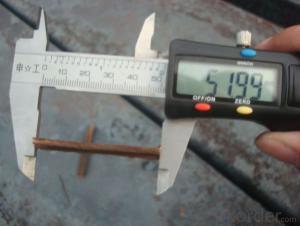Alloyed Steel Billet/Bloom by Continue Casting Blast Furnace
- Loading Port:
- Tianjin
- Payment Terms:
- TT OR LC
- Min Order Qty:
- 1000 m.t.
- Supply Capability:
- 10000 m.t./month
OKorder Service Pledge
OKorder Financial Service
You Might Also Like
Alloyed Steel Billet/Bloom by Continue Casting Blast Furnace
1.Structure of Alloyed Steel Billet/Bloom by Continue Casting Blast Furnace
Continue Casting Steel Billet Manufactured By Blasting Furnace is the raw material of all kinds of steel mill. Billet section of square, round, flat, rectangular and abnormity, etc Several, mainly related to shape of rolled products. Simple rolled section steel, choose cross section of square billet or rectangular billet. rolling The sector products such as flat steel, Angle steel, select the rectangular billet or slab. Had better profiled billet when production beams, channels, and in rolling process Lines and improve the yield. The raw material of round billet is the production of seamless tube.
2.Main Features of Alloyed Steel Billet/Bloom by Continue Casting Blast Furnace.
Continue Casting Steel Billet Manufactured By Blasting Furnace section size should meet the requirements of rolling deformation and finished product quality, but also roll strength and biting condition of restrictions. General steel Billet section height H. And the roll diameter D The ratio of the ( namely H/D) Should be less than or equal to zero 0.5 . Length of steel billet by finishing temperature, Rolling time and the length of the product Or times ruler. When heated too long accident prone to bump the furnace wall of steel, too short, furnace bottom utilization rate is not high, influence the heating furnace production. For the production Choose a variety of steel and steel billet, should consider the affinities of billet, as far as possible in order to improve the productivity of the roughing mill, simplify the stock management of workshop.
There are three shapes of the steel billets: square billet, slab, rectangular billet The Chinese billet, rectangular billet is mainly suitable for rolling hot rolled strip, building reinforced bar, Ordinary wire, high speed wire rod and various small profile. Of the slab are mainly used for rolling plate and hot coil sheet.
3. Alloyed Steel Billet/Bloom by Continue Casting Blast Furnace Images
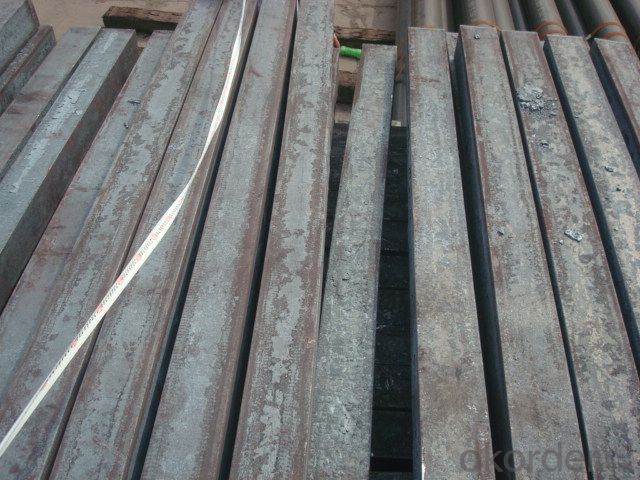
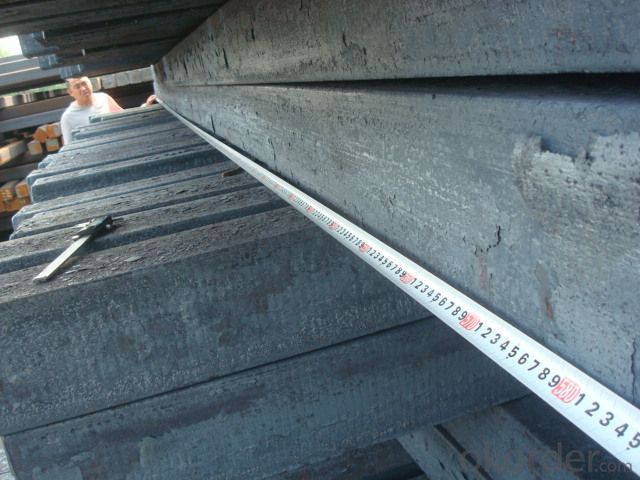
4. Alloyed Steel Billet/Bloom by Continue Casting Blast Furnace Specification
Continue Casting Steel Billet Manufactured By Blasting Furnace rolled steel, after processing can be used for mechanical parts, forging parts, processing all kinds of steel, steel Q345B channel steel, wire rod is the role of the billet. Steel billet is used in the production of semi-finished products, generally cannot be used directly for the society. Steel billets and steel are strictly divided into standard, cannot decide to whether the business enterprise of the final product, and according to unified standards to perform the whole society. Typically, billet and the steel is relatively easy to distinguish, but for some steel billet, and have the same specification and same steel purposes (such as rolling tube billet), whether can be used for other industries, whether through steel processing process, whether through a finished product rolling mill processing to distinguish
Material standard The editor Range of thickness: 150-240 - mm + / - 5 mm width range: 880-1530 - mm + / - 20 mm Length: 3700-10000 - mm + / - 500 - mm Cross-sectional size: 64 * 64; 82 * 82; 98 * 98; 124 * 124; 120 * 150; 152 * 164; 152 * 170 mm Length: 9000 mm Section of tolerance: billet: 1.0 + / - 2.0-1.0 + / - 1.0 mm slab: width: + / - 2.0 mm thickness: + / - 3.0 mm The length tolerance: + / - 200 mm Section diagonal tolerance: 3.5-8.0 MM Billet section size protrusions requirements: < 1242 mm, do not allow; > = 1242 mm, < = 2 mm 1242 mm, < = 3 mm Beheading (shear) extension deformation: < 1242 mm billet: no control; The slab: < = 15 mm Surface tilt: no more than billet section 0.1 Bending: every 1 m length is not more than 10 mm The distortion: length < = 5 m, < = 11. ; The length of the < = 7.5 M, < = 5. Material % 3 sp/PS chemical composition: C Mn Si S P
5.FAQ of Alloyed Steel Billet/Bloom by Continue Casting Blast Furnace
We have organized several common questions for our clients,may help you sincerely:
①What kinds of the steel billet you have?
We usually export the Q195/215/235/275, size: 120*120/130*130/150*150*12000/6000mm steel billet to our customers..
②Could we get the third party quality inspecting report?
Sure, but the inspecting fee belong to our customers payment in advanced.
③What quality problem we could claim?
Any problem not meet the contract you can tell us and we will be respansible for you.
For example:The defect of billet according to its source can be divided into two categories:Lack of steelmaking and castingAnd the rolling defects caused by.From the defect of the parts and can be divided into two kinds of surface defects and internal defects.The main steel billet defectsThere should be: scar, crack, cracking and inclusions(See the non-metallic inclusions), shrinkage residual(See the shrinkage cavity), airbag, air bubble, insideCrack, burnt, internal heat, tail hole, teeth marks, folding, scratches, indentation, sag, Angle, bending(See the bending),Handle defects, torsion, crack, shear, mesh, cleaning up bad, skull patch, seam crack, split, out-of-tolerance and sizePitting, etc.
1)Airbags.Boiling steel billet shearing area appear similar to the defects of shrinkage cavity.Section on the vertical axis of symmetry of the tongueWave, wave gap in granular inclusions, blaze, discoloration, etc.Sometimes the surface of the bulge, tearing, shearing widthSuch as large surface phenomenon, finished product billet surface convex hull, cross section on the tongue shape wave, serious billet through a long hole.
- Q: How are steel billets used in the manufacturing of railway wagons?
- Steel billets are used in the manufacturing of railway wagons as they serve as the raw material for various components such as frames, side panels, and undercarriages. These billets are first heated and then shaped into the desired form through processes like rolling or forging. The resulting components are strong, durable, and able to withstand the rigorous demands of railway transportation, ensuring the safety and reliability of the wagons.
- Q: How is the market for steel billets influenced by global economic trends?
- Global economic trends have a significant impact on the market for steel billets. Steel is a crucial raw material for industries like construction, automotive, and manufacturing, so any changes in the global economy can greatly affect the demand and pricing of steel billets. During periods of economic growth, there is typically an increased demand for steel products, including steel billets. This is because there are more construction projects and infrastructure development happening during these times. The demand is driven by increased consumer spending, urbanization, and government investments in infrastructure. Therefore, factors like GDP growth, industrial production, and construction activity are vital in determining the demand for steel billets. On the other hand, during economic downturns or recessions, the demand for steel billets tends to decrease. This is due to reduced consumer spending, fewer construction projects, and a slowdown in manufacturing. Global economic indicators, such as GDP contraction, industrial output decline, and reduced infrastructure investment, can negatively impact the market for steel billets. In addition to economic trends, global trade policies and tensions also influence the market for steel billets. Tariffs, quotas, and trade disputes between countries can disrupt the supply chain of steel billets, leading to price volatility and market uncertainty. Measures to protect domestic industries or restrictions on steel imports can limit the availability of steel billets in certain regions, affecting market dynamics and pricing. Currency exchange rates also play a role in the steel billet market. Fluctuations in currency values can affect the competitiveness of steel billet exports and imports. A strong domestic currency may make exports more expensive, reducing foreign demand for steel billets. Conversely, a weak currency may make imports more expensive, potentially increasing demand for domestically produced steel billets. In conclusion, the market for steel billets is closely tied to global economic trends. Economic growth, industrial production, construction activity, trade policies, and currency exchange rates all impact the demand, supply, and pricing of steel billets. Understanding and monitoring these global economic trends is essential for stakeholders in the steel industry to make informed decisions and navigate market fluctuations effectively.
- Q: What are the different methods of steel billet surface polishing?
- There are several methods of steel billet surface polishing, including mechanical polishing, chemical polishing, electropolishing, and abrasive blasting. Mechanical polishing involves using abrasive materials and machinery to remove surface imperfections and create a smooth finish. Chemical polishing utilizes chemical solutions to dissolve and remove surface impurities, resulting in a polished surface. Electropolishing involves the use of an electric current to dissolve and remove surface material, resulting in a smooth and shiny finish. Abrasive blasting uses high-pressure air or water to propel abrasive particles onto the surface, removing contaminants and creating a polished appearance.
- Q: How are steel billets inspected for quality control?
- Steel billets are inspected for quality control through a series of rigorous tests and inspections. The process starts with visual inspection, where the billets are examined for any visible defects or irregularities in shape, size, surface finish, or any signs of cracks or inclusions. After the visual inspection, the billets undergo various non-destructive testing techniques such as ultrasonic testing (UT) and magnetic particle inspection (MPI). UT uses high-frequency sound waves to detect any internal flaws or defects in the billets, while MPI uses magnetic fields and iron particles to identify surface cracks or discontinuities. In addition to non-destructive testing, destructive tests are also conducted to assess the mechanical properties of the billets. These tests include tensile testing, where a sample is subjected to tension until it breaks to measure its strength and elongation properties. Hardness testing is performed using various methods like Rockwell or Brinell tests to determine the billet's resistance to indentation or deformation. Chemical analysis is another critical aspect of quality control. Samples are taken from the billets and subjected to spectroscopic analysis to determine the chemical composition, ensuring that it meets the required specifications and standards. Furthermore, dimensional measurements are carried out to verify the billets' accuracy in terms of length, diameter, and other dimensional tolerances. This is done using precision measuring tools such as micrometers and calipers. Overall, a combination of visual inspection, non-destructive testing, destructive testing, chemical analysis, and dimensional measurements is employed to ensure the quality of steel billets. These comprehensive quality control measures help identify any defects or inconsistencies, guaranteeing that the billets meet the required standards and are suitable for further processing in the steel industry.
- Q: How are steel billets used in the production of transmission towers?
- Transmission towers require steel billets, which are semi-finished steel products, as a crucial component for their production. The first step in the process is to heat the steel billets in a furnace at extremely high temperatures. This hot rolling process softens the billets and makes them more malleable, enabling easy shaping and forming into the desired structure of the transmission tower. Once heated, the billets are then passed through rolling mills, where they are shaped into long, cylindrical sections known as steel bars. These bars are further processed and cut to the required length and dimensions based on the specific design and requirements of the transmission tower. Following the shaping and cutting, the steel bars undergo galvanization, which involves coating them with a protective layer of zinc. This zinc coating provides corrosion resistance, safeguarding the tower from environmental elements like moisture and rust. Finally, the galvanized steel bars are assembled and welded together to create the intricate framework of the transmission tower. The usage of strong and durable steel billets ensures that the tower can withstand heavy loads and extreme weather conditions. In conclusion, steel billets are essential for the production of transmission towers due to their strength, flexibility, and corrosion resistance. Their ability to be shaped and formed into the desired dimensions, along with their durability, make them an ideal material for constructing transmission towers.
- Q: How are steel billets reheated before rolling or forging?
- Steel billets are reheated before rolling or forging by passing them through a furnace or a reheating furnace, which raises their temperature to a specific range. This process, known as billet reheating, is crucial as it improves the billets' malleability, making them easier to shape and work with during the subsequent rolling or forging operations.
- Q: What are the different grades of steel used for making billets?
- There are several different grades of steel used for making billets, including low carbon steel, mild steel, medium carbon steel, high carbon steel, and alloy steel. The specific grade chosen depends on the desired properties and characteristics required for the intended application of the billets.
- Q: How do steel billets contribute to the manufacturing of agricultural equipment?
- Due to their versatility and durability, steel billets are essential for the manufacturing of agricultural equipment. These semi-finished steel products serve as the foundation for various agricultural machinery. To begin with, steel billets are crucial for creating the main structural components of agricultural equipment, including tractors, harvesters, plows, and tillers. These components, such as the chassis, frame, and axles, require a strong and sturdy material to withstand the heavy loads and harsh conditions encountered in agricultural operations. Steel billets provide the necessary strength and resilience to ensure the equipment's ability to endure the rigors of farming. Moreover, steel billets are used to manufacture smaller parts and mechanisms that are vital to the functioning of agricultural machinery. Gears, sprockets, shafts, and bearings, for instance, are commonly made from steel billets. These parts play a crucial role in transmitting power and facilitating the smooth operation of various agricultural equipment. Additionally, steel billets contribute to the longevity and reliability of agricultural equipment. The high strength and durability of steel ensure that the machinery can withstand the demanding agricultural environment, including exposure to moisture, dirt, and extreme temperatures. This durability reduces maintenance requirements and extends the equipment's lifespan, resulting in cost savings for farmers. Furthermore, steel billets offer the advantage of being easily shaped and molded into complex designs. This enables manufacturers to create customized agricultural equipment tailored to specific farming needs. The flexibility in design allows for the production of specialized machinery for various agricultural operations, such as planting, harvesting, irrigation, and livestock management. In conclusion, steel billets are indispensable in the manufacturing of agricultural equipment as they provide the necessary strength, durability, and versatility required for the demanding conditions of modern farming. Their contribution ensures that farmers have access to reliable and efficient machinery, ultimately increasing productivity and supporting sustainable agricultural practices.
- Q: What are the different types of steel billet forging machines?
- There are several different types of steel billet forging machines available in the market today. These machines are designed to efficiently shape and form steel billets into desired shapes and sizes. Here are some of the common types of steel billet forging machines: 1. Hydraulic Forging Press: This type of machine uses hydraulic power to exert force on the steel billet, allowing it to be forged into the desired shape. Hydraulic forging presses are known for their high force capabilities and versatility in handling different sizes of billets. 2. Mechanical Forging Press: Mechanical forging presses use mechanical power, such as flywheels or eccentric mechanisms, to exert force on the billet. These machines are known for their reliability and precision, making them suitable for high-volume production. 3. Screw Press: Screw presses utilize a rotating screw mechanism to apply force on the steel billet. They are characterized by their high-speed operation and efficient energy usage. Screw presses are commonly used for forging small to medium-sized billets. 4. Hammer Forging Machine: Hammer forging machines use a hammering action to shape the steel billet. There are various types of hammer forging machines, including steam hammers, air hammers, and hydraulic hammers. These machines are known for their high impact force, making them suitable for heavy-duty forging. 5. Upsetter: Upsetters, also known as upsetting machines, are specifically designed for forging the ends of steel billets. They use a vertical or horizontal ram to apply pressure on the billet, causing it to increase in diameter and length. Upsetters are commonly used for producing forged components with thickened ends. 6. Radial Forging Machine: Radial forging machines employ a rotating roller to apply radial force on the steel billet. This force causes the billet to increase in diameter while maintaining its original length. Radial forging machines are often used for producing seamless rings and other cylindrical components. It's important to note that the choice of the most suitable steel billet forging machine depends on factors such as the size and shape of the billet, desired production volume, and specific requirements of the final product. Each type of machine has its own advantages and limitations, so it is crucial to consider these factors when selecting the appropriate forging machine for a given application.
- Q: What is the role of steel billets in the manufacturing of offshore structures?
- Steel billets play a crucial role in the manufacturing of offshore structures. These structures are subjected to harsh environmental conditions, such as corrosive saltwater, high winds, and extreme temperatures. Therefore, it is essential to use materials that are strong, durable, and resistant to corrosion. Steel billets provide the raw material necessary to create these offshore structures. They are semi-finished steel products that are manufactured through a process called casting. Billets are typically rectangular or square in shape and have a cross-sectional area that is larger than that of a finished product. This allows for further processing and shaping into various components of the offshore structure. Once the steel billets are obtained, they undergo a series of manufacturing processes, including heating, rolling, and shaping, to transform them into the desired structural elements. These elements can include beams, columns, plates, and other components that form the framework of the offshore structure. The use of steel billets offers several advantages in the manufacturing of offshore structures. Firstly, steel is known for its exceptional strength and durability. It can withstand the immense forces exerted by the ocean waves and provide structural stability to the offshore platform or rig. Steel also has excellent fatigue resistance, allowing it to endure constant loading and unloading cycles without weakening. Additionally, steel billets can be easily welded, which is essential for the construction of offshore structures. Welding enables the joining of various components, ensuring the overall integrity and strength of the structure. This allows for the creation of large and complex structures that can withstand the harsh marine environment. Moreover, steel billets have excellent corrosion resistance properties. Offshore structures are constantly exposed to saltwater, which can cause corrosion and degradation of materials. However, steel can be treated with protective coatings or alloys to enhance its resistance to corrosion, ensuring the longevity and safety of the offshore structure. In conclusion, steel billets are fundamental in the manufacturing of offshore structures. They provide the raw material necessary to create strong, durable, and corrosion-resistant components that form the framework of these structures. By utilizing steel billets, offshore structures can be built to withstand the demanding conditions of the marine environment and ensure the safety of workers and the longevity of the structure.
Send your message to us
Alloyed Steel Billet/Bloom by Continue Casting Blast Furnace
- Loading Port:
- Tianjin
- Payment Terms:
- TT OR LC
- Min Order Qty:
- 1000 m.t.
- Supply Capability:
- 10000 m.t./month
OKorder Service Pledge
OKorder Financial Service
Similar products
Hot products
Hot Searches
Related keywords
